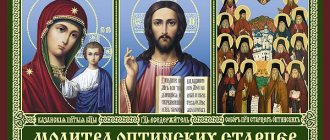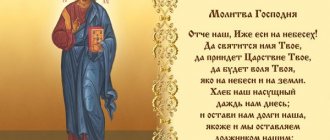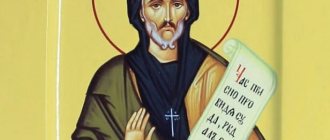Gospel of the Nazarenes
The Nazarenes were another early sect of Christianity. They were named after Nazareth, the birthplace of Jesus. Scholars believe that the Gospel of the Nazarenes was written in the 2nd century, like many other gospels. Like Ebionites
, the Nazarenes also observed Jewish customs and laws. Their Gospel also emphasized Jesus' Jewish origins [even though he was from Galilee].
Interestingly, this Gospel was written in Aramaic, the language Jesus spoke. When the Bible was compiled, this Gospel was rejected for many reasons similar to those of the Ebionite Gospel. Moreover, at that time, few people still read or spoke Aramaic. Greek became the official language of Christianity. Only small portions of this Gospel, translated into other languages, survive today.
Collections of apocryphal literature
- Library "Apocrypha"
- Nag Hammadi Library in Russian
- Library of Russian religious, philosophical and fiction literature “Vekhi” (apocrypha, Josephus, ancient Armenian sources...)
- Russian Apocryphal Studio (the largest collection of apocrypha in Russian). Nag Hammadi Library. New Testament and Old Testament apocrypha. Hermeticism and Gnosticism. Scrolls of the Judean Desert. Research and references.
- Slavonic Pseudepigrapha - Slavic Apocrypha
- Square of Heretics - Apocrypha and opinions on Christian history and doctrine.
Close candidates for canonization
While many of the books listed here were considered heretical (especially those belonging to the Gnostic tradition, as that sect was considered heretical by Proto-Orthodox Christianity in the early centuries), others were not considered particularly heretical in content, but were in fact well received as important spiritual works. Those marked with a diamond (♦) are also included in the collection known as the Apostolic Fathers.
Although some of the following works appear in complete Bibles of the fourth century, such as 1 Clement and the Shepherd of Hermas, showing their general popularity, they were not included when the canon was officially established at the end of that century.
- and 2 Clement ♦
- Shepherd of Hermas ♦
- Didache ♦
- Message of Barnabas ♦
- Apocalypse of Peter
- Third Epistle to the Corinthians
The Apocrypha was written out of revenge, for fame and to convey their ideas to the masses.
There is no single answer to the question why the apocrypha was written. Everything depends greatly on the topic of a particular text and the era of its creation. For example, the following motives are known:
Revenge . Christians and Jews had many opponents, and therefore this is a rather sophisticated way of taking revenge - to write a biblical text that could undermine the foundations of a creed, or confirm its secondary nature in relation to another religion. A striking example is the apocryphal Gospel of Barnabas. Its author describes New Testament events in a context favorable to Islam.
Sermon . How to convey your religious ideas to the masses? It is clear that an anonymous text or manuscript by an unknown person will not be of interest to the public. But if you include your teaching in the hitherto unknown Epistle of the Apostle Paul, for example, then interest in the text will increase significantly. And the critical attitude towards the text will disappear. This method was especially popular among the Gnostics. The same Gospel of Mary is a Gnostic sermon, but in the mouth of Christ it acquires great meaning for the reader.
In the apocrypha of the Gospel of Mary, Mary Magdalene appears as the best disciple of Christ
Thirst for fame . “If I don’t become famous myself, then at least my text will go down in history,” the falsifiers reasoned and composed texts of biblical content, completely devoid of any spiritual meaning. Usually these are just fictional plots that expand on well-known Jewish and Christian plots. The Childhood Gospel of Thomas is an example of this type of writing.
This text is full of stories about the supernatural abilities of Jesus Christ, which carry no moral, spiritual, or sacred meaning. This makes the text similar to myths about the childhood of gods and heroes (for example, Krishna and Hercules), but does not add anything to Christian teaching.
Gospel of Peter (Nazarenes)
Fragment of the Gospel of Peter
was discovered in Egypt in 1886 in the tomb of a medieval monk;
the Apocalypse of Peter
and
the Book of Enoch
were also located there . The manuscript itself on parchment dates back, in all likelihood, to the 8th-9th centuries, but the text was created much earlier.
This gospel claims to have been written by Peter, a close friend of Jesus and his disciple. However, it is not. First, this was written at least a century after Peter lived. It also uses all four canonical Gospels as sources.
Scholars suggest that this gospel was popular for a time, but was later rejected by the church. Many of the teachings in the text are supposedly outdated and heretical. For example, it is stated that Jesus did not suffer on the cross. Like most apocryphal early Christian gospels, only an incomplete text survives from it.
Theodoret (IV-V centuries) wrote: “The Nazarenes are Jews who honor Christ as a just man and use the so-called Gospel of Peter.” The Apostle Peter (Simon) was also revered by the Ebionites
who rejected the teachings of St. Pavel.
- Gospel of Peter
- Gospel of Peter (extant passage)
- Gospel of Peter
- Gospel of Peter. Analysis.
Gospel of Philip
The Gospel of Philip claims to have been compiled by one of Jesus' followers. But it differs significantly in style and content. Most of the gospels focus on narrating the life of Jesus, but it reads more like a sermon or treatise. It contains many of the familiar concepts and rituals of Christianity (such as baptism), but the author refers to them as allegories rather than actual rituals. This is one of the most complex and difficult gospels to understand [perhaps the most correct to understand].
This book was probably rejected for several reasons. First, her philosophy is very different from what most Christians are used to[?]. Also, some of the statements in this manuscript do not even sound like Christianity, but rather like other religions of the ancient world (for example, Manichaeism
).
Gospel of the Savior
This was one of the most recently discovered Gospels. In 1997, American scientists examined the archives of the Berlin Museum. Among a stack of ancient manuscripts they found what appeared to be fragments of a never-before-seen gospel. Much of the text was damaged, but enough remained to indicate what the complete book was. Like the canonical Gospels, this book tells the story of Jesus, minus various details.
In this text, Jesus does many of the same things that he does in the Bible, but at different times and places [update or earlier version?]. For example, his famous phrase “if only You would take this cup away from Me” is spoken in a dream, and not in the garden. The Gospel of the Savior was probably written in the second century, but there are almost no historical references to it.
The fight against the apocrypha after the Nativity of Christ
With the rise of Christianity, there was an even greater need to separate the officially accepted books of the Bible from the various alternative apocryphal interpretations written at different times and by different people. Some of them were written by completely pious, albeit naive, people who wanted to explain and supplement the Holy Scriptures in their own way (for example, “The Virgin’s Walk through the Torments” describes the descent of the Mother of God into hell and then her representation before the throne of the Son). Other apocrypha were born in various widespread early Christian sects, and heretical movements and in Gnosticism using Christian themes. There were also authors who specifically, allegedly on behalf of the apostles revered in Christianity, compiled and distributed “messages” that were compromising the official Church, which, in their opinion, hid the originally true teaching. Therefore, Christians at all times tried to defend, from their point of view, the true “purity of their faith,” and at all times, at councils, they compiled lists of renounced books (apocrypha), which were forbidden to be read, and which were searched for, torn, burned, or cleared/washed off parchments apocryphal texts and other palimpsests were written.
In modern Christianity, only 27 books are included in the New Testament canon and are recognized as inspired books, which, according to the church, were written directly by the apostles (secular witnesses of Christ). The composition of the New Testament canon is enshrined in the 85th Apostolic Canon. Together with the books of the Old Testament, they form the Christian Bible, which contains a total of 77 books. It is all these inspired books that are considered the only authoritative source in matters of sacred history and dogma in the main Christian denominations.
However, the writing of inspired books did not stop with the death of the apostles. The Orthodox Church has been replenished and continues to be replenished with a huge number of works (writings) of the Holy Fathers, liturgical texts and descriptions of the lives of saints, which, after a careful and comprehensive study for compliance with the Holy Scriptures (Bible), are also recognized as inspired and obligatory for all Christians. Therefore, these religious books, which are not directly part of the Bible, are not considered apocrypha.
The ancient apocrypha that has survived to our time has not only historical significance, but to some extent also dialectical, since they reflect the views of Christians of the first centuries.
The apocrypha includes the so-called Old Testament apocrypha, apocryphal Gospels, Acts, Apocalypses, etc., as well as alternative “official” biographies of saints.
Apocrypha is also composed in our time, when various sects, certain “elders”, soothsayers and “miracle workers” publish and distribute religious literature that interprets in their own way the history and principles of Christian doctrine.
Content
- 1 Definition
- 2 History 2.1 Development of the New Testament canon
- 2.2 Modern science and translation
- 3.1 Canonical gospels
- 4.1 Dialogues with Jesus
Messages
Main article: Messages
There are also non-canonical epistles (or "letters") between individuals or Christians in general. Some of them were very highly regarded by the early church. Those marked with a diamond (♦) are included in the collection known as the Apostolic Fathers:
- Message of Barnabas ♦
- Epistles of Clement ♦
- Epistle of the Corinthians to Paul
- Epistle of Ignatius to the Smyrnaeans ♦
- Epistle of Ignatius to the Trallians ♦
- Polycarp's Epistle to the Philippians ♦
- Epistle to Diognetus ♦
- Epistle to the Laodiceans (an epistle on behalf of Paul)
- Epistle to Seneca the Younger (an epistle on behalf of Paul)
- The third letter to the Corinthians is accepted in the past by some into the Armenian Orthodox Church.
Diatessaron - unification of the 4 gospels by Tatian
Diatessaron [Greek dia tessaro:n, lit. - through four], the name of “ gospel harmony”
", compiled
by Tatian
around 170 using the 4 canonical Gospels and some non-canonical sources. Tatian created a single narrative about the life and teachings of Jesus Christ, while eliminating repetitions and coordinating parallel passages.
Along with patristic quotations from the 2nd century. Diatessaron
is one of the earliest evidence of the text
of the New Testament
and therefore is of paramount importance for New Testament textual criticism (Leloir. 1956. P. 209).
According to some researchers, the Diatessaron sometimes transmits readings that are earlier than those recorded in the extant manuscript tradition of the NT
(Petersen. 1994. P. 1).
The Diatessaron was the standard gospel text in the Syrian Church until the 5th century. and was quoted for several centuries thereafter by Syriac authors. Traces of the influence of the Diatessaron text are found over vast territories - from China ( Manichaean
fragments from the city of Turfan) to England and, possibly, Iceland (Ibid. P. 2). Many textual scholars suggest that the Gospel translations - into Syriac, Latin and Armenian - first appeared in the form of the Gospel Harmony, most likely the Diatessaron (Ibidem). Therefore, studying the history of the translation of the Holy Scriptures into these languages is impossible without drawing on the data of the Diatessaron (Ibid. P. 3).
The Diatessaron preserves materials from the tradition that are not found in the canonical Gospels; Some of these materials are present in the works of the early Church Fathers (for example, Martyr Justin the Philosopher, Martyr Irenaeus of Lyons, St. Hippolytus of Rome), but were rejected for some reason during the formation of the Gospel canon. Thus, the Diatessaron plays an important role in the study of the formation of the New Testament canon (Vogels 1955: 144; Petersen 1994: 3).
- Diatessaron in the Orthodox Encyclopedia
Deuterocanonical books
After the death of Ezra, his followers (zealots of piety) continued their search, and those books that were found were relevant and those that were written in subsequent centuries (for example, the Maccabees) were selected by them as inspired. But the rigor and meticulousness of the selection, as well as the indisputable authority and traditions of Ezra, did not allow innovations to be introduced into the established canon of the Holy Books. And only in the fairly free and enlightened city of Alexandria, where there was a rich library of antiquity, when translating the Old Testament books into Greek, 72 Jewish interpreters and translators, after deep study, diligent prayers and debates, added (in the Greek text) to the previous 39 books 11 books. It was this version (Septuagint) that became the main one for Christians who spoke predominantly Greek in the first centuries of Christianity.
When Protestants, using ancient handwritten originals, began to translate the Bible into modern national languages, they discovered the absence of these 11 books in all Jewish texts and hastened to declare these books apocrypha (although they did not prohibit them, but only declared them of little importance). It should be noted that even some canonical books (which do not confirm their views) raise doubts among Protestants.
These 11 non-canonical (deuterocanonical) books, that is, books not included in the original canon of Ezra, are revered in Orthodoxy in the same way as all other books of the Bible; they are also used during public worship (read in proverbs), along with the canonical ones. Nowadays, thanks to the successes of biblical archeology, Jewish texts previously considered lost have also become known for some books.
Sources
- Cameron, Ron (1982). Other Gospels: Non-Canonical Gospel Texts
. Westminster / John Knox. ISBN 978-0-664-24428-6. - Ehrman, Bart D.; Plesche, Zlatko (2011). "The Judeo-Christian Gospel." The Apocryphal Gospels: Texts and Translations
. Oxford University Press. pp.197–216. ISBN 978-0-19-973210-4. 216. - Elliott, James Keith (2005) [1993]. Apocryphal New Testament
. Oxford University Press. ISBN 978-0-19-826181-0. - Schlarb, Egbert; Luhrmann, Dieter (2000). "Hebräerevangelium". Fragmente apokryph gewordener Evangelien in griechischer und lateinischer Sprache
(in German). N.G. Elwert Verlag. ISBN 978-3-7708-1144-1. 6868179M. - Vilhauer, Philipp; Strecker, Georg (1991). Schneemelcher, Wilhelm; Wilson, Robert McLachlan (ed.). Apocrypha of the New Testament: The Gospels and Related Writings Volume 1
(2nd ed.). John Knox Press. ISBN 0-664-22721-X. (6th edition in German, translated by George Ogg) - Yamauchi, Edwin M. (1979). "Apocryphal Gospels". In Bromiley, Geoffrey W. (ed.). International Standard Bible Encyclopedia: A–D Volume 1
. Wm. B. Eerdmans. pp. 181–88. ISBN 978-0-8028-3781-3.
Gospel of Truth (Valentine)
The Gospel of Truth was probably written in the 2nd century, possibly by an ancient Christian philosopher named Valentine. The title of the book suggests that it was written to correct ideas in the other gospels. However, like the Gospel of Philip
, this book is not a classic gospel, because... does not contain a description of the life of Jesus or details of his deeds. Instead, it reads like a sermon or a theological text.
This Gospel was rejected because of its content. Most of its texts are difficult to understand and it is very different from the canonical gospels. It was criticized by the most ancient Christian writers for its inconsistencies, and the Gospel of truth was quickly declared heretical. Today its text is available almost in its entirety.
- Reflections of the concept of the Trinity in the Gnostic “Gospel of Truth”. Alexey Koltsov
- "The Bruce Code". Translation from Coptic - A. Moma.
Miscellaneous
These texts do not fit into other categories in their content or form:
- Apostolic constitutions (church decrees supposedly approved by the apostles)
- Book of Nepos
- Canons of the Apostles
- Treasure Cave (also called Treasure
) - Clementine literature
- Didache (possibly the first written catechism) (also included in the collection known as the Apostolic Fathers.)
- Liturgy of St. Jacob
- Origen's repentance
- Paul's Prayer
- Sextus' verdicts
- Physiologist
- Bee book
General definitions
According to the definition of the “Church Dictionary” by P. A. Alekseev (St. Petersburg, 1817), these are “hidden, that is, books published unknown from whom, or that are not publicly read in the church, as the Holy Scripture is usually read. Such books are all those that are not in the Bible.” That is, apocryphal books for the most part distort the principles of revealed teaching, and they cannot generally be recognized as divinely inspired (for example, due to the too strong element of human wisdom). Therefore, these books were mercilessly persecuted by the Fathers of the Church and were not included in the canon of revealed books of the Old and New Testaments (the Bible).
There are apocrypha that slightly diverge from Christian doctrine and, in general, confirm the Holy Tradition of the ancient Church, for example in iconography and worship: there is an apocrypha called the “Proto-Gospel of James” - it is not recognized by the Church as inspired scripture, but is accepted as evidence of Church Tradition. And most of the feasts of the Mother of God - the Nativity of the Virgin Mary, the Entry into the Temple, and partly the Annunciation (this was reflected in the iconography) are confirmed by the Proto-Gospel of James. This text is called apocrypha not in the sense that it contains something contrary to Holy Scripture. In many ways, it is simply a fixation of Church Tradition.
Apocalypse
Main article: Apocalyptic literature
Some works are visions, often discussing the future, the afterlife, or both:
- Apocalypse of Paul (as opposed to the Coptic Apocalypse of Paul, also called Apocalypse of the Virgin Mary.)
- Apocalypse of Peter (as opposed to Gnostic Apocalypse of Peter)
- Apocalypse of Pseudo-Methodius
- Apocalypse of Thomas (also called The Revelation of Thomas
) - Stephen's Apocalypse (also called Stephen's Revelation
) - First Apocalypse of Jacob (also called First Revelation of Jacob
) - Second Apocalypse of Jacob (also called Second Revelation of Jacob
) - Shepherd of Hermas (also part of the collection known as the Apostolic Fathers)











